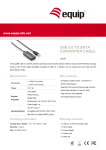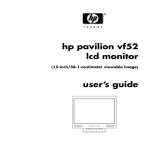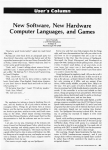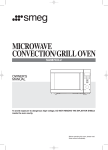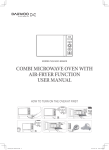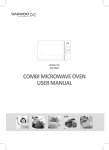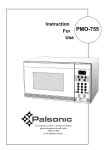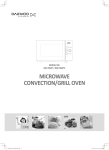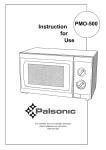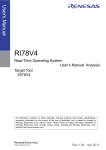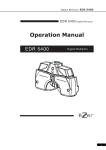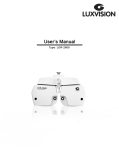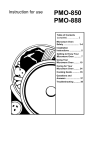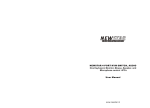Download Palsonic PMO-800 User's Manual
Transcript
MICROWAVE OVEN PMO-800 INSTRUCTION MANUAL IMPORTANT Before operating your microwave oven, please read the operating instructions completely and retain this manual for reference. Please also record the following details: Model number: Serial number: Purchase date: Dealer’s name: Dealer’s address: CONTENTS SPECIFICATIONS ........................................................................... 1 OPERATING INSTRUCTIONS ....................................................... 2 Safety precautions to avoid possible exposure to excessive microwave energy ...................................................................................................... 2 Important safety instructions ................................................................... 3 Electrical requirements ............................................................................ 5 Grounding instructions ............................................................................ 5 Features ................................................................................................... 6 Control panel ........................................................................................... 7 Installation ............................................................................................... 8 How to operate ........................................................................................ 8 Trouble shooting ..................................................................................... 18 SPECIFICATIONS MODEL: PMO-800 AC line voltage: Power consumption: See rating label Output power: 800W Microwave frequency: 2450MHz Capacity: 30 litres Outside dimensions: (W x D x H) 537mm x 403mm x 341mm (21.1" x 15.9" x 13.4") Net weight (approx.): 20.1 kg (44 lbs) 1 OPERATING INSTRUCTIONS PRECAUTIONS TO AVOID POSSIBLE EXPOSURE TO EXCESSIVE MICROWAVE ENERGY (a) Do not attempt to operate this oven with the door open since open-door operation can result in harmful exposure to microwave energy. It is important not to defeat or tamper with the safety interlocks. (b) Do not place any object between the oven front face and the door or allow soil or cleaner residue to accumulate on sealing surfaces. (c) Do not operate the oven if it is damaged. It is particularly important that the oven door closes properly and that there is no damage to the: (1) door (bent), (2) hinges and latches (broken or loosened), (3) door seals and sealing surfaces. (d) The oven should not be adjusted or repaired by anyone except properly qualified service personnel. IMPORTANT: The microwave oven is designed for household use only. It must not be used for commercial operation. 2 IMPORTANT SAFETY INSTRUCTIONS When using electrical appliances, basic safety precautions should be followed, including the following: WARNING - To reduce the risk of burns, electric shock, fire, injury to persons or exposure to excessive microwave energy. 1. Read all instructions before using the appliance. 2. Read and follow the specific "PRECAUTIONS TO AVOID POSSIBLE EXPOSURE TO EXCESSIVE MICROWAVE ENERGY" found on page 2. 3. This appliance must be grounded. Connect only to properly grounded outlet. See "GROUNDING INSTRUCTIONS" found on page 5. 4. Install or locate this appliance only in accordance with the provided installation instructions. 5. Some products such as whole eggs and sealed containers - for example, closed glass jars - may explode and should not be heated in this oven. 6. Use this appliance only for its intended use as described in this manual. This oven is specifically designed to heat, or cook food. and is for domestic use only. It is not designed for commercial, industrial or laboratory use, Do not use the microwave oven for other than cooking purposes. 7. As with any appliance, close supervision is necessary when used by children. 8. Do not operate this appliance if it has a damaged cord or plug, if it is not working properly, or if it has been damaged or dropped. 9. This appliance should be serviced only by qualified service personnel. Contact nearest authorized service facility for examination, repair or adjustment 10. Do not cover or block any openings on the appliance. 11. Do not use outdoors. 12. Do not immerse cord or plug in water. 13. Keep cord away from heated surfaces. 14. Do not let cord hang over edge of table or counter. 15. When cleaning surfaces of door and oven that comes together on closing the door, use only mild, non-abrasive soaps or detergents applied with a sponge or soft cloth. 16. Do not heat substances containing or producing corrosive chemicals and vapors, such as sulfides and chlorides in oven and avoid using such cleaning agents containing such chemicals to clean the oven. 17. To reduce the risk of fire in the oven cavity: (a) Do not overcook food. Carefully attend appliance if plastic or paper. other combustible materials are placed inside the oven to facilitate cooking. (b) Remove wire twist-ties from paper or plastic bags before placing bag in oven. 3 (c) If materials inside the oven should ignite, keep oven door closed, turn oven off, and disconnect the power cord, or shut off power at the fuse or circuit breaker panel. 18. Install your oven as directed and with adequate ventilation provided all round. 19. Microwave oven should not be operated without food inside. Operation in this manner is likely to damage the oven. 20. Metal and electroplated material should not be put inside the oven when operating. 21. Do not lean on the door; this could cause mis-alignment of the door. 22. Do not remove the outer case, door or control panel at any time to ensure that you will not be exposed to excessive microwave energy. 23. Do not use the oven for storage of paper or cooking utensils. 24. Be certain the turntable inside the oven is in place when you operate the 25. Handel the glass turntable carefully. It is fragile. 26. Preheating times for microwave browning dishes vary depending on the size of the browning dish and food being cooked DO NOT REHEAT BROWNING ON DISH THE GLASS TURNTABLE MORE THAN 5 MINUTES. A SUITABLE INSULATOR SUCH AS A MICROWAVE AND HEATPROOF DINNER PLATE SHOULD BE PLACED BETWEEN THE TURNTABLE AND THE BROWNING DISH IN ORDER TO PREVENT THE TURNTABLE FROM OVERHEATING. SAVE THESE INSTRUCTIONS 4 ELECTRICAL REQUIREMENTS 1. The microwave oven must be plugged directly to a 3-prong wall receptacle which is properly grounded. 2. Use power source of 10 amps minimum capacity and as specified on the label at the back of the microwave oven. 3. This unit must be fully grounded at all times. Do not under any circumstances cut or remove the third (ground) prong from the power cord. 4. Because of potential safety hazards under certain conditions, we strongly advise against the use of an adaptor GROUNDING INSTRUCTIONS This appliance must be grounded. In the event of an electrical short circuit, grounding reduces the risk of electric shock by providing an escape wire for the electric current. This appliance is equipped with a cord having a grounding wire with a grounding plug. The plug must be plugged into an outlet that is properly installed and grounded. WARNING - Improper use of the grounding plug can result in a risk of electric shock. Consult a qualified electrician or serviceman if the grounding instructions are not completely understood, or if doubt exists as to whether the appliance is properly grounded. 5 FEATURES 1. Safety door lock system (latches) - governed by three built-in safety devices to ensure that the oven automatically cuts out and stops functioning the moment the door is opened. 2. See-through oven window with perforated metal inlaid in plastic. 3. Ventilation openings with projected spacer to allow proper airflow. 4. Removable roller ring. 5. Removable glass turntable improves cooking uniformity. 6. Control panel. 7. Press to open oven door. 6 DISPLAY WINDOW-the digital display counts down the cooking time when the oven is in use The indicator light will show the cooking mode CLOCK - this feature function as a clock when the oven is not in use DEFROST-uniform thawing is preset at power 3 MICROWAVE COOK Set cooking time for microwave cook. Power will be automatically set POWER LEVEL-it ranges from 1 to 10 NUMBER keys for programming cooking time and power level: and setting the clock POPCORN/PIZZA- touch ONCE for cooking popcorn: touch TWICE for cooking pizza BAKED POTATO-easy touch key for baking potatoes ONE MINUTE PLUS/QUICK COOK touch ONCE to cook for 1 minute at power level 10. or to increase cooking time by 1 minute START-much this key to commence cooking. 7 INSTALLATION NOTE: This microwave oven is not designed for built-in use. 1. Make sure all packing materials have been removed from the oven. Visual check after unpacking Check the oven for any damages, such as misaligned door. damaged gaskets around door or dents inside the oven cavity or on the door. If there is any damage. do not operate the oven until it has been checked by an authorized service personnel and any repairs made, if necessary. 2. The oven should be placed on a flat and stable counter, table or cart. 3. The oven should be placed away from high temperature and steam. 4. Exhaust vents are provided on the back of the oven for proper cooling and airflow in the cavity. Never allow anything to cover the air vents and there should be at least 2" (5cm) clearance at the.air vents to permit adequate air circulation. 5. Place turntable inside the oven cavity and be sure that it is seated properly on the roller ring. 6. Read through all the precautions and the operating instructions before operating the oven. 7. Diagram for installing the turntable. Glass tray Ring Turntable shaft Cavity 8 HOW TO OPERATE THE MICROWAVE OVEN 1. Plug your oven into a 3 prong grounded outlet. Be sure that your microwave oven is the only appliance on the circuit. 2. Set clock (see page 11 for setting). 3. Push button to open door 4. Close door securely. 5. Set function pads. 6. Touch START pad. 7. An audible signal will sound at the end of the cooking cycle and the oven will turn off automatically. 8. Cancel any entry for cooking, when food has been removed from oven during operation. NOTE: Cooking may be interrupted at any time during operation for turning or stirring of food. When the door of the oven is open, oven stops producing microwave energy instantly. To continue cooking re-close the door and touch START pad again. Previously set programme will not be wiped off. 9 HOW TO OPERATE THE FUNCTION KEYS SETTING THE CLOCK This feature functions as a 12-hr clock. DO NOT input numbers exceeding 1259. To set the clock, follow this procedure when you first plug in your oven. After your oven is plugged in, the letters 88:88 will appear in the display window. Touch the CLOCK key and then touch the appropriate number pads in sequence. PROCEDURE DIGIT CLOCK DISPLAY INDICATOR 88:88 When oven is plugged in 1. Touch CLOCK key CLOCK 2. Touch number key 808 :0 On 8:08 On 3. Touch Clock Pad to set. MICROWAVE COOK The microwave oven has a 99 minute 99 second timer for cooking operations. Once Microwave Cook is set, the microwave oven will operate at maximum power (power level 10) automatically, but this does not appear in. the display. If another power level is desired, then touch POWER LEVEL key and the power level required EXAMPLE 1: Setting 1 minute at. power level 10 COOKING EXAMPLE: Melt butter MICROWAVE COOK DIGIT PROCEDURE KEY INDICATOR DISPLAY 1. Place food in oven and close door 2. Touch MICROWAVE COOK key 3. Touch desired number keys 4. Touch START key MICROWAVE COOK 100 | START :0 On 1:00 On The display will show the set cooking time counting down till the cooking cycle is finished. An audible signal will sound and the display will return to the day clock. NOTE: If you wish to check the power level, touch POWER LEVEL key. The power level will be displayed for a few seconds. and then the display will change back to cooking time. 10 Example 2: Setting 5 minutes cooking time at power level 7 COOKING EXAMPLE: Reheating two plates of food PROCEDURE 1. Place food in oven and close door 2. Touch MICROWAVE COOK key 3. Touch number keys for desired cooking time 4. Touch POWER LEVEL key 5. Touch number key for power level 6. Touch START key KEY MICROWAVE COOK 500 POWER LEVEL 7 DIGIT DISPLAY MICROWAVE COOK INDICATOR :0 On 5:00 P-10 On On P-7 On | START The display will show the cooking time counting down from 5 minutes to zero. Power level 7 does not show, unless power level key is touched. Note: If you want to change the power level during cooking, touch the POWER LEVEL key and then enter the power level you wish to use. MICROWAVE COOK Your microwave oven is ideal for defrosting frozen food quickly and evenly. and has a special defrost facility for this. Simply touch DEFROST key and power level 3 is automatically set. Example: Defrost for 10 minutes COOKING EXAMPLE: Defrost 450g/ 1 lb fish fillets PROCEDURE 1. Place frozen food in oven and close door 2. Touch DEFROST key 3. Touch number keys for desired defrosting time 4. Touch START key KEY DEFROST 1000 | START DIGIT DISPLAY :0 DEFROST INDICATOR On 10:00 On The display will show the defrosting time counting down from 10 minutes to zero. 11 PROGRAMMED COOKING You can programme your microwave oven to a combined cooking sequence of a maximum of three stages. 1) TWO STAGES a) MICROWAVE COOK - MICROWAVE COOK, at different power level Cooking can start off with high power level and finish cooking at a lower power level. or vice versa. Note: If the power level of the second stage of cooking is different from the first stage, POWER LEVEL key should be touched again for the desired setting otherwise power level 10 will automatically set at the second stage of cooking., Example: MICROWAVE COOK,8 minutes at power level 10 - MICROWAVE COOK, 20 minutes al power level 5. MICROWAVE PROCEDURE DIGIT COOK KEY DISPLAY INDICATOR 5. Touch POWER LEVEL key MICROWAVE COOK 800 MICROWAVE COOK 2000 POWER LEVEL 6. Touch number key 5 1. Touch MICROWAVE COOK key 2. Touch number keys 3. Touch MICROWAVE COOK key 4. Touch number keys 7. Touch START key | COOKING EXAMPLE: Beef stew START :0 On 8:00 On :0 On 20:00 On P-10 On P-5 On The display will show 8 minutes of counting down and followed by 20 minutes. b) MICROWAVE COOK - MICROWAVE COOK Microwave cook, using the same power level to prolong the cooking time. COOKING EXAMPLE: Turkey 2) THREE STAGES DEFROST - MICROWAVE COOK - MICROWAVE COOK Defrost food and cook straight away, using two different power levels COOKING EXAMPLE: Frozen cheese fondue. 12 INDEPENDENT FUNCTIONS Four quick cooking functions are provided to suit your convenience in cooking the most common foods. The cooking result will vary according to the initial temperature of the foods. Adjustment in cooking time may be necessary. A) POPCORN A program has been installed to heat a bag of popcorn weighing about 100g PROCEDURE KEY DIGIT DISPLAY POPCORN PIZZA INDICATOR POPCORN PIZZA PC On 2:30 On 1) Place a bag of microwave popcorn in oven and close door 2) Touch POPCORN/PIZZA key once 3) Touch START key START B) PIZZA Another program has been installed to cook a pizza of approximately 350g in weight. PROCEDURE KEY DIGIT DISPLAY POPCORN PIZZA INDICATOR POPCORN PIZZA PI On 5:00 On 1) Place a frozen pizza in oven and close door 2) Touch POPCORN/PIZZA key twice 3) Touch START key START REMARK: The key POPCORN/PIZZA operates alternatively. 13 C) BAKED POTATOES A programme has been pre-set to microwave 2 potatoes, weighing approximately 230g each. PROCEDURE KEY DIGIT DISPLAY BAKED POTATO INDICATOR BAKED POTATO PO On - 7:00 On - 1) Place 2 potatoes in oven and close door 2) Touch BAKED POTATO kev 3) Touch START key START 4) MINUTE PLUS/QUICK COOK This is a convenient key programmed to microwave food for one minute at power Level 10. COOKING EXAMPLE: To reheat a piece of chicken. PROCEDURE KEY DIGIT DISPLAY MICROWAVE COOK INDICATOR 1) Place foodstuff in oven and close door 2) Touch MINUTE PLUS/ QUICK COOK key MINUTE PLUS/ QUICK 1:00 On 3) Touch START key START 1:00 On 14 REMARK: This key can also be used to programme microwave cook for more than one minute. PROCEDURE KEY DIGIT DISPLAY MICROWAVE COOK INDICATOR 1) Place foodstuff in oven and close door 2) Touch MINUTE PLUS/ QUICK COOK key once MINUTE PLUS/ QUICK COOK twice triple 3) Touch START key START 1:00 On 2:00 3:00 On On 3:00 On 15 CLEANING & CARE OF YOUR MICROWAVE OVEN IMPORTANT Be certain oven is unplugged before cleaning. NEVER USE A COMMERCIAL CLEANER OR ANY ABRASIVE POWDERS OR PADS OR ANY CLEANING AGENTS CONTAINING OR PRODUCING CORROSIVE CHEMICALS AND VAPORS, SUCH AS SULFIDES AND CHLORIDES ON OR IN ANY PART OF THE MICROWAVE OVEN. Exterior Clean the surface with soap and warm water, then rinse and dry with a soft cloth. Water should not be allowed to seep into the ventilation opening to revent damage to the operating parts inside the oven. Clean the control panel of your microwave oven only with a damp cloth. DO NOT USE CLEANING SPRAYS OR LARGE AMOUNTS OF SOAP AND WATER. These can cause problems with the control mechanisms, Always keep the door seal and door surface clean by wiping with a damp cloth, to prevent grease, soil or spatters from building up. Interior walls If steam accumulates inside or around the outside of the oven door, wipe with a dry cloth. Wipe the interior walls and the ceiling with mild detergent, rinse and wipe dry with a piece of soft cloth. Odors can be eliminated from the inside of the oven. by boiling a solution of one cup of water and several tablespoons of lemon juice in the oven for 5-7 minutes. This also helps to loosen any dried soil in the oven. Be very careful not to scratch the door and interior surface, Wipe out any spillages or splashing on the turntable after use. It is also occasionally necessary to remove the turntable and the roller ring for cleaning and to clean the floor of the oven. Wash the turntable and roller ring in mild soapy water, then rinse and dry. Be sure that the roller ring and turntable are put back in their proper places before operation. 16 TROUBLE SHOOTING OVEN WILL NOT WORK IF: The power plug is not fully inserted.. One of the house fuses has blown. Door is not closed properly. Time has not been set. You have not entered START’ You have entered a new program without cancelling the old one. You have not entered numbers after Time Cook. CANCEL/OFF’ pad was touched accidentally. The oven is overheated. A thermal sensitive safety device will automatically turn the oven off. The oven will be operable again when it has cooled sufficiently. INCORRECT PROGRAMMING An incorrect data will not be accepted by the built-incomputer; you will see nothing happen when an incorrect pad is touched. If a cooking programme is entered incorrectly, you can cancel the program by touching the CANCEL/OFF pad and re-enter the correct full program. MICROWAVE OVEN TURNED ON ACCIDENTALLY WITH NO FOOD IN THE OVEN Touch ‘CANCEL/OFF’ pad immediately to cease all operation. A cup of water left in the oven will absorb the microwave energy if the oven is accidentally turned on. COOKING TIMES IN COOKBOOK DO NOT SEEM RIGHT FOR YOUR FOOD Foods vary in size, type and shape. These may cause cooking times to differ from those given in the cookbook. House power varies too. Food has not stirred as required in recipe. NOTE: If food is not heated at all when a cooking program has been entered, call for service. CONDENSATION Steam accumulating inside and outside of the oven door and air vents is a normal sign of microwave cooking. Wipe out excess moisture with a piece of soft cloth after every operation. 17 MICROWAVE COOKING GUIDE INTRODUCTION The advantages of a microwave oven A microwave oven is most useful for its speed in cooking. Speedy cooking of meals can be very helpful in some busy families. Microwave cooking roughly takes about one third to one quarter of the conventional cooking time. Of course this varies according to the density, temperature and the amount of food being cooked. Foods are cooked so quickly in a microwave oven that they can be cooked in their own juices, with less or no seasonings at all, thus retaining all their natural flavours. A microwave oven saves energy because energy is only consumed during the actual cooking time. There is no preheating and no cooling down for a microwave oven, so no energy is consumed and wasted. A microwave oven does not become hot during cooking; only the foods get hot. The kitchen remains coal always, and this means comfort to the cook. Microwave cooking also means less washing-up. Foods can be cooked and served in the same container, as they do not get hot during cooking in a microwave oven. Spatters and spills do not burn on the oven walls, so it is easy to keep the oven nice and clean. Do not worry if you forget to defrost the meat. The microwave oven can defrost frozen food in a matter of minutes. Cooking can then begin immediately. Reheating of foods in a microwave oven is also another advantage for late comers in the family. Reheating of food will not spoil its appearance and flavour. 18 The theory of microwave cooking When the microwave oven is plugged in. the ordinary electrical current is converted to microwaves by a tube called a magnetron. The microwaves are of very short wave length and high frequency The waves are then channelled into the cavity of the oven. Distribution of microwaves is evenly done by a stirring fan installed in the oven. The oven walls will reflect the microwave energy directly to the food, causing its molecules to vibrate at an incredibly high speed. These vibrations generate the heat that cooks the food, without heating the oven or cooking container. although a container may sometimes be warmed subsequently by the conduction of heat from the food cooked in it. Once the door of the oven is opened, during or after cooking, the magnetron producing microwaves automatically switches off. and cooking by microwave energy stops instantly. Microwaves cook in three ways: 1. Microwaves are reflected to the foods by the metal walls of the oven. Never use metal utensils or utensils with metal trims, because they reflect microwaves away from the food. 2. Microwaves are transmitted through certain substances such as paper. plastic, glass and ceramic without producing heat. Cookware made of these materials are sometimes suitable for use in a microwave oven. For further details. see "Cooking Utensil" 3. Microwaves are attracted to the liquid. sugar, fat or moisture content in foods, causing them to vibrate at an incredibly high speed. As the vibrating molecules rub against each other, this causes friction. thereby creating heat within food. 19 MICROWAVE COOKING UTENSILS You can test your cooking utensils to see whether they are microproof or not. Do this simple test. Put a glass half full of water in the microwave oven. Place it on top of or next to the dish. Microwave for one minute at full power. If the water becomes hot, the dish is microwave-safe. If on the otherhand, the dish is warm or hot, this means that the dish has been absorbing microwave energy, and should RECOMMENDED Metal Small pieces or strips of aluminium foil may be used to shield parts of food, such as tips of poultry, wings or legs or the thin ends of joints. Shallow TV dinner trays less than 3/4 inch (1 1/2cm) deep can be used, but foil lids should be replaced with wax paper or plastic wrap. Glass, ceramic and china All ovenproof glass and ceramic cookware can be used. Ordinary glass and china can be used only for short-term heating. Plastic Plastic cookware designed specifically for microwave cooking, microwave plastic cooking bags or boilable bags are all acceptable. Always puncture bags before cooking to prevent bursting. Plastic wrap can make a good tight seal when used to cover cooking dishes during microwaving. Turn back one corner to allow steam to escape. Foam cups and dishes should be used for short-term hearing only. Paper Paper plates and cups can be used for short-termcooking or re-heating. Paper towels and wax paper are best used for covering cooking dishes, heating rolls and sandwiches, because they keep the food moist. Wood and straw Small wooden utensils and straws can be used for very short periods. not be used in the microwave oven. For most oven cooking, a round dish is preferable to oval or rectangular dishes, because food cooked in corners allow more exposure to microwaves. Over cooking at comers may occur. There are also a number of cooking utensils designed for microwave cooking on sale in the market. Always check manufacturers’ instructions. NOT RECOMMENDED Metal Metal dishes or utensils and those with any form of metal trim or decoration are not recommended, because metal reflects microwaves. This will cause arcing (sparks), and damage to the dish and the oven magnetron. Foil plates more than 3/4 inch (1 1/2 cm) in depth, foil-lined paper bags or boxes, sheets of aluminium foil, conventional meat thermometers, pewter or silver dishes, pots and pans are not to be used. Use string or elastic bands to replace metal twist-ties which are often supplied with cooking bags. Glass Delicate glassware and lead crystal should be avoided. Plastic Melamine dishes plastic bags used for freezing or storage Should not be used. Paper Paper of any kind should not be used in the oven for prolonged periods. This causes the paper to ignite Wood and straw Large wooden utensils should not be used as the microwave energy may cause the wood to become dry and brittle. 20 SAFETY RULES FOR MICROWAVE COOKING 1. If cling-film or plastic wrap is used to cover food, turn back one corner to vent, thus preventing burns from the steam trapped underneath. Be careful when removing cover to avoid scalding from hot steam. 2. Always use oven gloves when handling browning dishes. Cooking utensils may sometimes become hot because of the heat transferred from the heated food. 3. Do not turn on the oven when it is not in use, to avoid damage to the oven and the danger of fire. 4. The prevent fire, do not sterilize baby bottles, melt paraffin wax, dry flowers, fruit, herbs, newspaper or clothes in the oven. 5. Eggs must not be cooked in their shells; egg yolks should be pricked, as should chicken livers, tomatoes and potatoes. Other foods with a skin, such as frankfurters must be pierced before cooking. 6. Popcorn is not recommended, unless packed in bags specifically designed for use in microwave ovens. 7. Narrow-necked bottles, baby food and canned foods should be avoided. 8. Never attempt to heat carbonated drinks, because pressure can accumulate. 9. No wire twist-ties, or metal of any kind are to be used; substitute them with string or rubber bands. 10. Deep fat frying must not be done in the oven as the fat could overheat. Excess fat and dripping from meat and poultry should be basted away during cooking, to prevent spattering. 11. Prick or pierce pouches, boiling and roasting bags before use. 12. Do not overheat food in paper and do not line the oven with paper. 13. Do not overcook food. Overcooking may result in fire. In case of fire, disconnect and keep the door closed. 14. Insert a wooden cocktail stick when testing cakes; do not use a metal skewer or stick. 15. Never use a conventional thermometer when cooking in the microwave oven. 16. Be careful when baking or heating sweet rolls: sugar or fruit filling can become very hot. Do not intake straight away, you may burn your tongue. 17. When heating TV foil tray, place it at least 1 inch (2 1/2 cm) from oven walls. TV trays should not be more than 3/4 inch (1 1/2 cm) deep. 18. Cancel cooking time when food is removed from oven. MICROWAVE COOKING TECHNIQUES Microwave cooking is very similar to cooking on the range top, i.e. simmering or steaming, but not too similar from oven cooking. Microwave cooking is a moist form of cooking. It does not produce food with crusts or browning. Timing is very important in microwave cooking because of the speed with which most food is cooked. Microwave cooking generally needs approximately one third of the time that is required in a conventional oven. It is better to under cook rather than over-estimate the cooking time. Food will still be cooking by heat conduction after it is removed from the oven. Overcooking of food has no remedy. Food can be examined easily by opening the oven door as many times as, you like. 21 Cooking time varies according to the temperature of the food. Food that is taken straight from the refrigerator takes longer to cook than food at room temperature and room temperature can vary too. Dense food will take longer to cook than porous food, because microwaves cannot penetrate deep into dense food. so the deeper part of food is heated and cooked by the conduction of heat from the outer surface. As the cooking time is determined by various factors, such as standing temperature, density, thickness and quality of the food, as well as the size, type and shape of dish used and sometimes by your own personal taste, the recipes given in this book have indicated a range of cooking time for your guidance. When you become more familiar with the oven, you will be able to adjust the cooking time to suit these factors. Here are some helpful techniques for microwave cooking. Standing time Food still continues to be cooked by conduction of heat towards the centre after it has been removed fram the microwave oven, or after the microwave oven has been turned off. This is called Standing Time. The Standing Time varies according to the volume and density of the food. To retain heat. large items of food such as poultry or roasts of meat should be wrapped in foil with shiny side in during standing time for 10-20 minutes. During this time, the internal temperature of meat or poultry will rise from 50C-100C. Turning and rotating It is possible that sometimes microwave energy is not distributed evenly in the cavity of the microwave oven. Food such as joints of meat or poultry should be turned over at least once during cooking. Placing of food Arrange the thicker parts of the food near the outside of the container, and place the easily heated thinner parts towards the centre. Try to arrange the food in a circular pattern and leave the centre space empty. The empty space in the centre will allow the microwaves to act more efficiently. Stirring Stirring is helpful. because food cooks from the outer edges inwards. Therefore stirring from the outer edges towards the centre during cooking encourages even cooking. 22 Sheilding The thinner ends of joints of meat, or fish or the tips of poultry wings or legs can be shielded with small pieces of aluminium foil, to reflect microwaves away from these areas, to prevent them from cooking too quickly. The foil must never touch the walls of the oven. Covering Covering of food retains moisture and prevents splashing in a microwave oven. If you wish to develop a drier surface, do not cover or use only a paper towel. Wax paper, paper towels, plastic wrap, glass lids and cooking bags can be used for covering during microwaving. If a cooking bag is used. tie the bag loosely with string, leaving a small space for steam to escape. Place the bag in baking dish. For prolonged period of cooking, paper towels must not be used. If covering is not specified in a recipe, food can be left uncovered. 23 Browning Food that requires more than 15 minutes cooking time will brown naturally. The fat in meat attracts microwaves. Food that cooks quickly, such as steaks, chops, hamburgers, can be browned by using a few drops of soy sauce. Quick bread and cakes do not brown, because there is no hot air in the oven to dry out the surface; therefore icing or toppings of cinnamon. sugar, coconut, chopped nuts, and soft brown sugar are recommended to add eye appeal. These can be sprinkled on the surface after half the cooking time. Bread or bread rolls can be brushed with beaten egg or milk and sprinkled with poppy seeds or cracked wheat before cooking. Using brown flour and brown sugar also adds colour to bread. You may use browning dishes which are on sale in the market, but read and follow the safety instructions carefully on page 4. Cooking Time variations Always start by trying the minimum cooking time and check for doneness. The cooking times given in this book can only be approximate. The cooking times may vary because of size, shape, temperature, thickness of the food and utensils used. Most of the recipes are for approximately two to four servings. Use slightly less than double the amount of cooking time when doubling a quantity. When cooking quantities are halved, the cooking time should be reduced to slightly more than half the time required in the recipe. 24 COOKING CHART Food Cover Power Level Cooking Time BEEF 1 lb (454g) ground beef 1 lb (454g) meatballs 1 lb (454g) hamburgers 1 lb (454g) meat loaf Lid/wax paper Wax paper wax paper Plastic wrap 10 10 10 10 4-7 minutes 9-12 minutes 4-6 minutes 15-20 minutes Pot roast Water: 1 cup per lb (454g) Lid 6 20-25 minutes per lb (454g) Tender roasts Wax paper 8 6-7 minutes per lb (454g) 7-8 minutes per lb (454g) 10-12 minutes per lb (454g) rare medium Well done Steaks PORK Bacon 1/2 lb (225g) pork sausages, raw Pork chops Pork roast spare-ribs Wax paper 2-4 minutes per lb (454g) Paper towel 10 3/4-1 minute per slice Wax paper Wax paper Wax paper 10 10 10 2-4 minutes I0-12 minutes per lb (454g) 11-12 minutes per lb (454g) Wax paper 10 7-9 minutes per lb (454g) Ham roast Precooked Raw Plastic wrap 1 1/2-2 lb (750g-910g) raw ham steaks 1 1/2 (750g)ham loaf Wax paper LAMB Roast leg or shoulder 10 6 11-14 minutes per lb (454g) 13-18 minutes per lb (454g) 8 18-25 minutes Plastic wrap 6 Wax paper 20-30 minutes 8 8-10 minutes per lb (454g) 25 Food Cover VEAL Roast shoulder Wax paper Power Level 8 Cooking Time 9-10 minutes per lb (454g) Plastic wrap Wax paper 10 Stewing, cut up Wax paper Cooking bag Wax paper Lid 10 10 10 8 2 1/2-3 minutes per piece 7-8 minutes per lb (454g) 8-9 minutes per lb (454g) 12-14 minutes per lb (454g) Comish hens Whole duckling Wax paper Wax paper 10 8 6-8 minutes per lb (454g) 9-11 minutes per lb (454g) Duckling pieces Turkey breasts Wax paper Plastic wrap 10 8 4-5 minutes per piece 8-9 minutes per lb (454g) Wax paper/ plastic wrap Plastic wrap Plastic wrap Plastic wrap Plastic wrap Plastic wrap Wax paper 10 7-9 minutes 10 10 10 10 10 10 4-7 minutes 3-5 minutes 5-7 minutes 5-7 minutes 8-11 minutes 5-8 minutes Wax paper 10 10-15 minutes Wax paper 10 6-8 minutes EGGS AND CHEESE Scrambled Poached Omelette Plastic wrap Wax paper 10 10 10 1-1 1/2 minute per egg 1-1 1/4 minute per egg 1-1 1/2 minute to melt butter 1 3/4-2 3/4minute per egg Quiche (9 in) (22.5cm) pie shell - 8 - 10 6 Lamb/veal cutlets/chops (3-4 pieces) POULTRY Chicken pieces Whole chicken FISH AND SEAFOOD 1 lb (454g) fillet/steaks 1 lb (454g) whole fish 1 lb (454g) clams/oysters 1 lb (454g) scallops 1 lb (454g) shrimps peeled Unpeeled 2 Crab legs (8-10 oz each) (225g-280g each) Whole lobster ( l-2 lb) (454g-910g) 2 lobster tails (8-10oz each) (225g-280g each) filling Custard (8 x 8 in) (20 x 2Ocm) 9-11 minutes 6-8 minutes 2-4 minutes 20-25 minutes 26 Power Level Cooking Time 10 8-16 minutes Lid 10 10 8-12 minutes 15-20 minutes Plastic wrap 10 Plastic wrap 10 6-7 minutes per lb (454g) 5-8 minutes per lb (454g) Lid/ plastic wrap Plastic wrap 10 15- 18 minutes 10 18-25 minutes Lid/ plastic wrap Lid/ plastic wrap Lid/ plastic wrap Lid/ plastic wrap Lid/ plastic wrap 10 13-18 minutes 10 18-25 minutes 10 18-20 minutes 10 3-6 minutes 10 30-35 minutes 10 2-3 minutes 10 3-5 minutes 10 3-4 minutes 10 13-16 minutes - 10 6-8 minutes - 10 8 6-7 minutes 3-3 1/2minutes 10 5-8 minutes 10 8 2-3 minutes 2-3 minutes Food Cover VEGETABLES Vegetables (l-2 lb) (454-910g) water: 1/4 cup Lid/ plastic wrap Potatoes(1 lb) (454g) baked boiled. water: 1 cup Corn-on-the-cob fresh in husk 2 frozen 2 RICE, PASTA AND CEREAL 8 oz (225g) macaroni. water: 3-4 cups 16 oz (454g) spaghetti. water: 6-7 cups 8 oz (225g) egg noodles, water: 3-4 cups 1 cup long grain rice, water: 2-3 cups 1 cup regular rice, water: 1 1/2-2 cups 1 cup minute rice. water:1 1/2-2cups 1 cup brown rice, water: 3 cups 1/2 cup quick oatmeal, water: 1 cup 1/2 cup long cooking oatmeal, water: 1 cup 1/2 cup cornmeal. water: 2 cups CAKES Carrot cake (10 x 6 in) (25cm x 15cm) Basic butter or chocolate cake 8-1/5in (21cm) round dish Ring cake Cupcakes (6) - - Bar cookies 8 in (20cm) square dish SOUP/BEVERAGE 1 cup water based 1 cup milk based - 27 DEFROSTING Rapid defrosting of food is one of the great advantages of the microwave oven. Before starting, make sure that you have removed any of the metal twist-ties which often come with frozen food bags, and replace them with strings or elastic bands. Containers such as cartons should be opened before they are placed in the oven. Always slit or pierce plastic pouches or packaging. If food is foil wrapped, remove foil and place it in a suitable container. Slit the skins of frozen food if any. Flex plastic pouches of food to ensure even defrosting. When large pieces of meat are defrosted, you should shield thin parts of poultry to slow down heating, otherwise, the outer edges will dry out, or even begin to cook. Always under-estimate defrosting time. If defrosted food is still icy in the centre, return to microwave oven for further defrosting. Allow standing time when defrosting because the defrosting process still continues during the standing time. The length of the defrosting time varies according to how solidly the food is frozen.Turn frozen food over or separate food if possible during defrosting or standing time. The defrosting chart is an approximate guideline to help you to thaw food in the microwave oven. 28 DEFROSTING CHART Food Recommended Time Suggestions MEAT 1 pack bacon Frankfurters Spare-ribs Ground meat 3-5 minutes 3-5 minutes per lb (454g) 7-8 minutes per lb (454g) 8-11 minutes per lb (454g) Leave packages unopened when defrosting. Microwave till foods can be separated. Turn over after half of defrosting time. Roast Beef Pork Lamb 6-8 minutes per lb (454g) 10-13 minutes per lb (454g) 10-12 minutes per lb (454g) Unwrap roast and place in cooking dish. Defrost till half of defrosting time and turn it over. Stand for ten minutes. Steaks, chops and cutlets 4-9 minutes per lb (454g) Sausages 4-6 minutes per lb (454g) Separate pieces after half of defrosting time. Turn over after half of defrosting time. POULTRY 1 whole chicken (2 1/2-3 1/2lb)(1 1/4-1 1/2kg) 18-22 minutes Place wrapped whole bird in oven when defrosting. Duckling (4-5 lb) (1 3/4-2 1/4 kg) Turkey 4-6 minutes per lb (454g) Unwrap after half of defrosting time. Shield warm areas with foil. Stand in cold water. Chicken pieces Turkey parts 6-8 minutes per lb (454g) 9-11 minutes per lb (454g) Comish hen 9-10 minutes per lb (454g) 9-11 minutes per lb (454g) Separate during half of defrosting time. Stand to complete defrosting. Place wrapped chicken in oven and turn over after half of defrosting time. 29 Food Recommended Time Suggestions FISH AND SEAFOOD 1lb (454g) fillets 8-10 minutes Leave package unopened when defrosting. Stand in cold water to separate. 2-3 minutes 4-6 minutes No mainpulation Place fish in cooking dish. Turn over once half way through defrosting time. Rinse cavity of fish with cold water. 6-8 minutes Break-up after half of defrosting time. 6-8 minutes No manipulation 16-18 minutes Turn over after half of defrosting time. 1 lb (454g) steaks 8-10 oz (225-280g) whole fish 1 lb (454g) small pieces of seafood, e.g. shellfish shrimps, crabmeat, oysters, etc. 6-9 oz (170-225g) lobster tails 1 1/2 lb (750g) whole lobster or crab BREAD AND CAKES 7 oz-1 lb (190-454g) bread, buns, rolls Doughnuts 12-17 oz (340-482g) poundcake/coffee cake, frosted, cream filled, or topped 2-4 minutes 1/2 minute each 2-5 minutes 17-19oz (482-539g) cheesecake 8 in (20cm) fruit or nut pie 14 oz (395g) cream or custard pie 5-7 minutes Cup cakes 1/2-1 minute 8-10 minutes 2-3 minutes VEGETABLES Vegetables are preferably cooked from frozen. Add 1-2 tablespoons of water. 30 RE-HEATING Cooked food and leftovers can be reheated quickly and efficiently without spoiling their freshness and taste. Always place the dense food at the outer edges and the more porous food towards the centre. To retain moisture during re-heating, cover the food with a microproof lid or plastic wrap, because covering the food retains heat and speeds heating. It also prevents spatters. For sandwiches and rolls, wrap them in paper towels loosely to absorb moisture and prevent sogginess. Spread food in a shallow dish if possible. Stirring and rotation of food is sometimes necessary even for re-heating. With so many combinations of food and numerous variations of food to be reheated, it may not be possible to provide you with the actual timing for re-heating. Therefore recommended re-heating time can only be offered as guidance. Always under-estimate re-heating time until you are used to the oven. 31 RE-HEATING CHART Power level: High Food 1 serving Plate of food 1-2 servings Saucy main dish 2-4 servings Thick meat slices, such as hamburgers, meat loaf slices 2-3 servings Thin meat slices, such as beef, ham, pork, turkey Chicken pieces 2-3 Cover Wax paper/ plastic wrap Lid /plastic wrap Wax paper / plastic wrap 2 servings Casserole Wax paper / plastic wrap Wax paper / plastic wrap Lid 2 servings l-2 ears 2-3 Vegetables Corn-on-the-cob Rolls Plastic wrap/lid Plastic wrap paper towel 1 1-2 slices 3-4 4 Whole pie Pie Sausages Hot dogs Wax paper Paper towel Power Level Cooking Time 10 2-3 minutes 10 7-10 minutes 10 3-5 minutes 8 2-3 minutes 8 3-4 minutes 8 9-12 minutes 10 10 10 10 10 10 10 3-4 minutes 3-4 minutes 1-1 1/2minutes 5-10 minutes l-2 minutes l-2 minutes 1 1/2-2minutes 32 PALSONIC CORPORATION PTY LTD 1 JOYNTON AVENUE WATERLOO NSW 2017 AUSTRALIA TEL:(02)9313 7111 FAX:(02)9313 7555 www.palsonic.com.au PALSONIC CUSTOMER SERVICE TELEPHONE AUSTRALIA: 1300 657 888




































